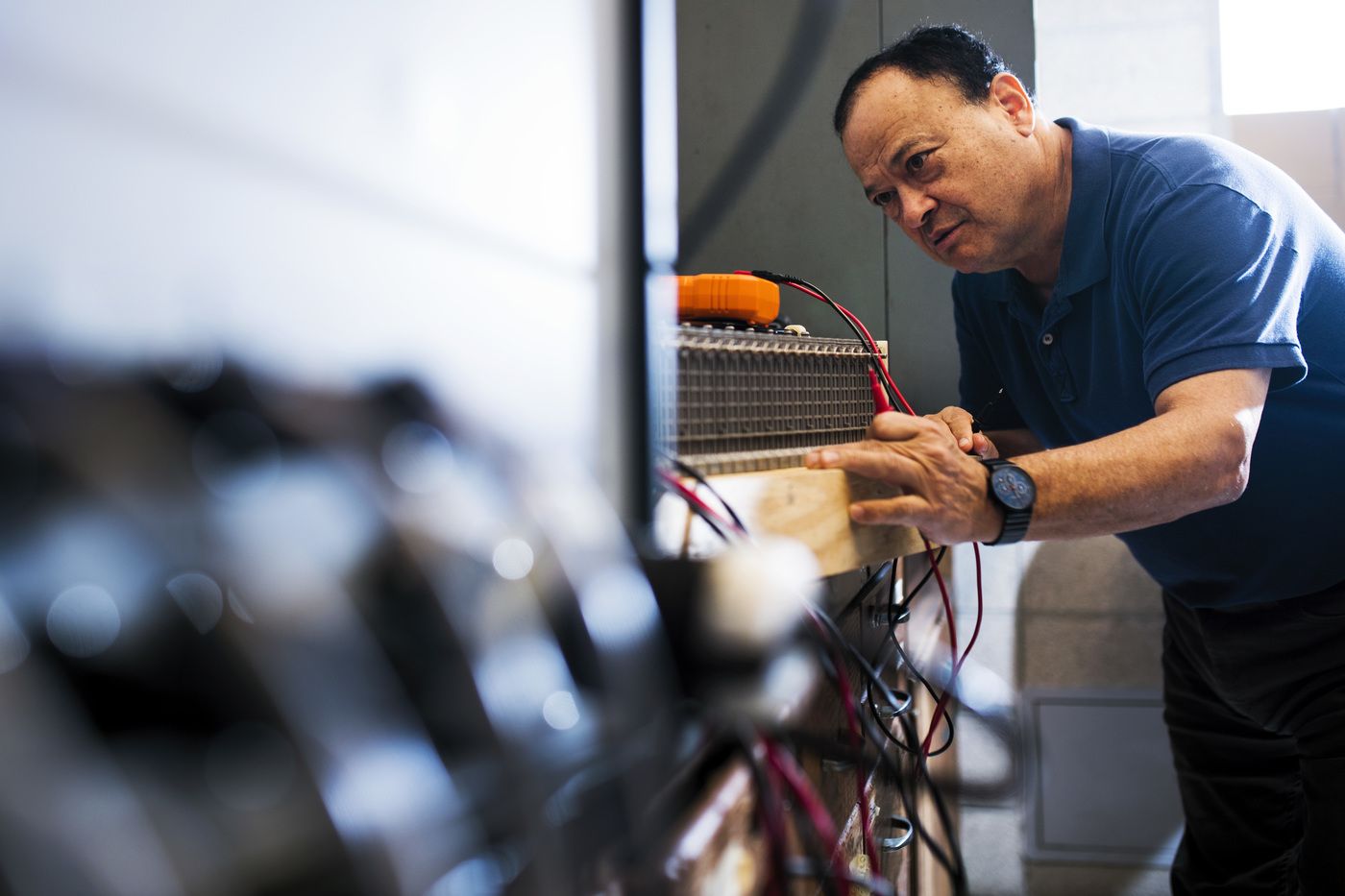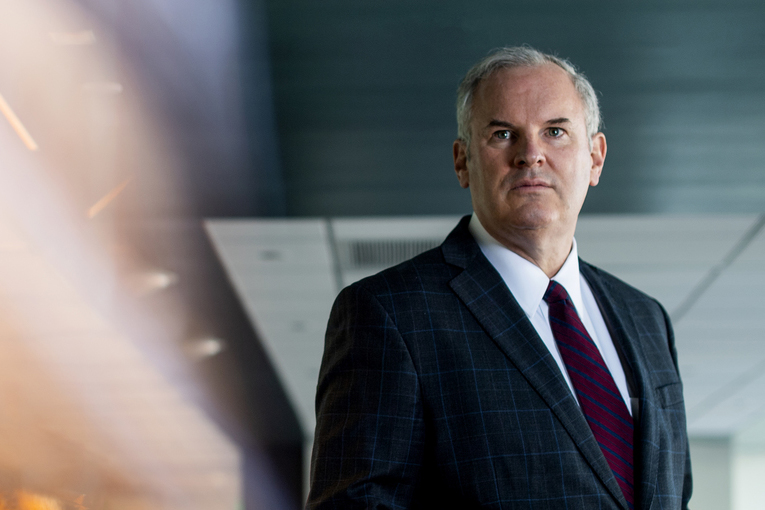What you can do to prepare your home for extreme heat

With the planet experiencing its hottest June ever and July heat records already popping like balloons, consider these strategies from professors at Northeastern to keep you and your loved ones cool—or at least cooler.
Since climate change, summer conditions and El Nino effects are reported to continue to keep temperatures high, the experts also describe collective and regulatory measures necessary to take stress off the energy grid and keep the air conditioning working.
Control your albedo, paint it white
People in hot climates know that painting their homes white keeps them cooler inside.
That’s because the color white has a high degree of albedo, a term that describes solar reflectivity, says Eugene Smotkin, Northeastern professor of chemistry and chemical biology.
Snow and ice also are high in albedo, while black asphalt is low in albedo—one reason why news reporters like to cook an egg on roadways during heat waves, Smotkin says.
Ways to control albedo include substituting white clam shell driveways for dark stones or painting driveways and rooftops white, Smotkin says.
If time and money are of the essence, you can do what he used to do with a too-sunny laboratory window in Hurtig Hall: cover east-facing windows with aluminum foil, shiny side out.

“I was able to solve a problem rapidly,” Smotkin says.
It works most effectively with the aluminum placed outside the window, he says.
Using reflective material inside the building space allows too much light to penetrate and dissipate into the building, which is why curtains and blinds help a little but not a lot, Smotkin says.
Residents of high rises and other people who can’t access the exterior of windows can use reflective material, such as aluminum backed by cardboard, inside the windows to dissipate heat.
To maximize cooling, insulate the aluminum-foiled window’s interior with whatever suitable product is on hand, Smotkin says. He lined the interior of his lab window with bubble wrap until the air conditioning system was upgraded.
Think like MacGyver
“I’m not saying live this way,” Smotkin says. But during brownouts and blackouts a little MacGyvering can go a long way.
For those who are less inclined to make do and willing to spend the money, “there is something called insulated foil,” Smotkin says. “Nothing beats that when you put that on the outside or the inside with the shiny side out.”
More permanent solutions—such as the aluminum foil-coated roof that tops his house in Puerto Rico—are available commercially and aesthetically pleasing.
Hurricane shutters, which are usually painted white, also work to keep out solar radiation, says Smotkin, the subject of a new documentary about the aftermath of Hurricane Maria, “Powering Puerto Rico,” that debuted recently at the Roxbury Film Festival.
He also recommends that everyone do what he did and set aside a room in their house or apartment as a “safe room” where all doors and windows are blocked and the air conditioner only has to cool a small area.
If the power shuts off completely, Smotkin uses what he calls a “swamp cooler” to chill the small space. In dire straits, the battery operated device is “extremely effective,” he says.
There are lots of websites and youtube sites online showing how to construct what is also known as an evaporative cooler.
Smotkin says air blowing on a water-saturated cooling pad in a five-gallon bucket drilled with holes can chill the air coming out of the pump to less than 70 degrees.
People can substitute a towel for the cooling pad, he says. A 12-volt battery, aquarium pump, five-gallon bucket with holes drilled halfway up the side, a fan and water make up the rest of the homemade cooler.

“This is so easy to build,” he says. “You will cool your safe zone down.”
People can also use 12-volt vehicle batteries to operate the cooler, Smotkin says. “Don’t be technologically too proud.”
He says he’d love to see people deliver the coolers to elderly residents during heat waves.
And on a societal level, Smotkin says it’s time to control our albedo by developing plans to make surfaces around cities more reflective and less absorbent of radiant energy.
“If the city distributed insulated foil, you could probably reduce the brownouts,” Smotkin says.
“It is probably expensive,” he continues. “But if the demand went up, the prices would come down. Certainly distributing to the elderly and having young Northeastern students installing, you would save a few lives.”
Don’t forget about conservation
Daily conservation efforts are way too overlooked, says Stephen Flynn, founding director of the Global Resilience Institute at Northeastern.
“We don’t do this routinely,” he says. “Conservation measures are touted as emergency measures.”
In the case of California’s record-breaking 2022 September heat wave, the public’s cooperation with conservation efforts prevented the grid from shutting down during what could have been a life-threatening event, especially for frail elderly people and people with health issues.
Conserving energy—and water—on a regular basis will lessen the stress on infrastructure, Flynn says.
And speaking of infrastructure, it’s time for new rules, he says.
The Bay area in California is experimenting with decentralized alternative energy networks known as mesh networks, Flynn says.
The idea is to use sustainable sources of energy—such as solar power—locally and then send the surplus to the main grid for wider distribution.
Utility companies and governments need to figure out how to make the economics of mesh networks work, Flynn says. More alternative sources of energy may mean fewer customers requiring services from the bigger utility companies, which need to remain economically viable to supply power to industry in California, he says.
The measures are necessary, with more than 7,000 daily temperature records broken the summer of 2022, according to The Washington Post.
World heat records were broken during consecutive days earlier this month, and Texas has been suffering under a “heat dome” that saw day after day of triple digits in parts of the state, as reported by USA Today.
“The race is on to see if we can pull this off,” Flynn says.
For media inquiries, please contact media@northeastern.edu.






